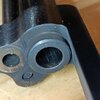So I got out to the range this weekend and shot my test rounds, checking the barrel after each group of six, taking pics from various angles. Also set up my Chrony F1 for the first time since picking it up last year, so I can add velocities to the data. I shot them in one order on Saturday, and then just for the sake of thoroughness I went back Sunday and shot them in reverse order. I was hoping that one load might stand out and produce obviously more leading than the others, but unfortunately that wasn't the case.
I'll spare you the complete spectrum of images I took and just give you one example. The pic below was taken after shooting six rounds of plated 148-grain wadcutters (just out of curiosity) and six rounds of coated 148-grain wadcutters. You can see obvious leading. From my observation it isn't only on one side of the cone, but is fairly evenly distributed around it. Average velocity was 812 fps.
View attachment 1146519
As a reminder, these are BHN 12 bullets from MBC that are Hi-Tek coated. I did the smash test with a hammer and found no compromising of the coating, and tried seating and pulling a bullet with identical results. But even if my limited testing was wrong and the coating was somehow compromised, I think I'm in about the right pressure/velocity neighborhood for a bullet of this hardness that there shouldn't be this much leading after only half a dozen shots, even from an uncoated cast bullet. If anything, maybe my pressure is too low and there's not enough obturation to prevent gas cutting. Is that possible?
By the time I got to my last two test loads, my group sizes had grown significantly, so I think the fouling is causing accuracy issues. Sure would like to figure this out because I don't want to have to scrub my barrel after every 24 shots. If I have to resort to plated and jacketed bullets I guess I can live with it but I'd rather find and address the cause.



![MBC_148_U_1[1].jpg MBC_148_U_1[1].jpg](https://www.thehighroad.org/data/attachments/1087/1087279-cc8cea17a5f19bbcace8e96452aae57f.jpg)





